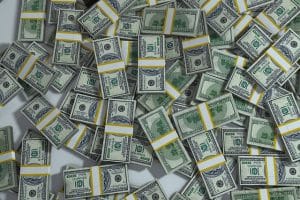Money supply is widely used as an indicator of economic performance in many countries. However, in today’s financial system, money is no longer restricted to cash. Different kinds of other tangible and intangible assets perform many or all of the functions of money. As a result, depending on our chosen scope, the money supply can be larger or smaller. However, most countries distinguish at least three money supply measures: M1, M2, and M3. We will look at the definition of money supply, its 3 types, its measures, and its importance. We’ll also see what happens if the money supply increases.
Money Supply Definition
The definition of “money supply” states that it is the total amount of currency and liquid assets in a country’s economy on the date measured. Cash and deposits that can be used almost as easily as cash is roughly included in the money supply.
Governments issue paper currency and coins using a combination of central banks and treasuries. Bank regulators affect the money supply available to the public by making banks keep reserves, deciding how to give out credit, and making other decisions about the money.
Understanding Money Supply
Economists study the amount of money in the economy and come up with plans to control interest rates and increase or decrease the flow of money into the economy. Public and private sector analysis is carried out because of the potential effects of the money supply on price levels, inflation, and the business cycle. The Federal Reserve’s policy is the most important deciding factor in the money supply in the United States. The money supply is also referred to as “money stock.”
Effect of Money Supply on the Economy
Most of the time, when the money supply goes up, interest rates go down. This means that people can invest more and spend more because they have more money. Businesses respond by increasing production and ordering more raw materials. Increased business activity increases the demand for labor. If the money supply falls or its growth rate worsens, the opposite can happen.
Money supply changes have long been thought to be a key factor in driving macroeconomic performance and business cycles. Irving Fisher’s Quantity Theory of Money, Monetarism, and the Austrian Business Cycle Theory are all macroeconomic schools of thought that put a lot of weight on the role of the money supply.
In the past, measuring the money supply has shown how it is related to inflation and price levels. But since 2000, these links have become less stable, making them less useful as a guide for monetary policy. Although money supply measures are still widely used, they are only one of many economic data points collected and reviewed by economists and the Federal Reserve.
What Are the 3 Types of Money Supply?
The most liquid asset is money in circulation in the form of a monetary base. However, there are other types of money supply held in various types of accounts that aren’t easily convertible into cash, and these are classified as M1 and M2.
Monetary Base
The monetary base consists of the currency in circulation as well as the deposit balances held by depository institutions with the Fed. The Fed adjusts the monetary base by buying and selling securities on the open market.
For example, the Fed purchases US bonds with a check deposited at a bank that has an account with the Fed. The amount on the check is added to the Fed’s reserves, which expands the monetary base. When the Fed sells bonds and receives a check from a bank, the monetary base shrinks. The bank’s balance with the Fed decreases when that check is deposited.
The monetary base, also known as “M0,” serves as the Federal Reserve’s balance sheet.
M1
M1 is a more general term for the money supply. It consists of the monetary base as well as other types of money, such as checkable (or demand) deposits and traveler’s checks. Demand deposits and traveler’s checks, on the other hand, are harder and take longer to turn into cash than cash and coins.
M2
M2 is made up of M1 plus savings, time deposits, and retail money market funds. Time deposits are usually for less than $100,000.
M3
M3 is made up of M2 and other measures of the money supply like institutional money market mutual funds and repurchase agreements. The Fed stopped publishing M3 data in 2006, claiming that it provided little more information on economic activity than M2 and that it no longer played a role in monetary policy decisions.
Measures of Money Supply
Money supply is an important economic indicator, so governments always keep an eye on and control it. As a result, they frequently measure the money supply to keep it in check. M1, M2, M3, and M4 are common measures of the money supply.
The supply is measured starting with the M0, or monetary base. It represents the amount of money in circulation, which includes currency bills, coins, and bank reserves.
- M1 money supply: Also known as ‘narrow money,’ it includes M0 and other highly liquid bank deposits.
- M2 money supply: This is the most widely used measure because it includes M1 as well as marketable securities and less liquid deposits.
- M3 money supply: Also known as “broad money,” it comprises M2 and money market funds such as mutual funds, repurchase agreements, commercial papers, and so on.
- M4 money supply: It consists of M3 and all other least liquid assets, which are typically held outside of commercial banks.
So, we can sum up the different ways to measure the money supply and their formulas as follows:
M0 = Currency notes + coins + bank reserves
M1 = M0 + demand deposits
M2 = M1 + marketable securities + other less liquid bank deposits
M3 = M2 + money market funds
M4 = M3 + least liquid assets
These measures of the money supply often differ by country. For example, the Federal Reserve usually measures the US money supply using M1 and M2 types, whereas the Bank of England also uses M4 types.
Money Supply Influencing Factors
There are numerous aspects to a country’s money circulation. For example, the determinants help influence and accurately quantify an economy’s supply situation.
- High-powered money: Cash and its equivalents, as well as bank deposits, are examples of high-powered money. Because they are highly liquid, they have a direct impact on the supply of money in an economy.
- Commercial bank reserves: In the event of an emergency, the central bank requires commercial banks to hold a certain percentage of deposits as reserves. Banks lend the excess reserve amount to consumers, causing money to circulate more freely.
- Reserve ratio: This is the central bank-mandated ratio of cash reserves to deposits. If the central bank raises the ratio, banks will have to keep more money in reserves, limiting their ability to lend.
- Public liquid cash: If people have more liquid cash at home, they will only spend a small portion of what is required. However, if the same money is deposited in a bank, the economy’s supply will be abundant.
Importance of Money Supply
Throughout the history of the United States, the money supply has expanded and contracted in conjunction with the economy. As a result, several economists, including Milton Friedman, cited the money supply as an essential indicator of the state of the national economy.
However, that perception of the money supply has shifted in recent decades. People began to withdraw money from low-interest savings accounts and invest it in the booming stock market in the 1990s. As a result, even as the economy expanded, M2 fell. Alan Greenspan, who was in charge of the Federal Reserve at the time, questioned how useful the money supply measurement was. He came to the conclusion that if the economy grew based on M2, it would be in a recession. The Federal Reserve no longer sets goals for how much the money supply should grow.
What Happens When Money Supply Increases
A rise in the money supply can increase consumer spending. It will, in turn, increase demand, causing prices to skyrocket. As a result, increased money circulation leads to inflation.
What Happens When the Federal Reserve Limits the Money Supply?
The money supply of a country has a significant impact on its macroeconomic profile, particularly in terms of interest rates, inflation, and the business cycle. In the United States, the Federal Reserve sets the level of monetary supply. When the Fed uses contractionary or “hawkish” monetary policy to limit the money supply in the economy, interest rates go up and it costs more to borrow money. This has the potential to reduce inflationary pressures while also slowing economic growth.
How Is Money Supply Determined?
A central bank controls the supply of money in a country. The central bank can use monetary policy to either grow the economy or make it shrink. Expansionary policies involve increasing the money supply through measures such as open market operations, in which the central bank purchases short-term Treasury bonds with newly created money, thereby injecting money into the economy. A contractionary policy, on the other hand, would involve the sale of Treasury bonds, removing money from the economy.
What Is the Distinction Between M0, M1, and M2?
In the United States, the money supply is classified by monetary aggregates such as M0, M1, and M2. These are used by the Federal Reserve to figure out how open market operations affect the economy. The monetary base, or M0, is made up of coins, paper money, and central bank reserves. M1, the most commonly used aggregate, includes M0 as well as demand deposits and travelers’ checks. Meanwhile, M2, which can be used as an inflation indicator when compared to GDP, includes M1 as well as savings deposits and money market shares.
Who is responsible for making policy decisions that change the money supply?
In the United States, the Federal Reserve is in charge of monetary policy actions and communications. Congress sets economic goals and tells the Federal Reserve how to reach them through monetary policy.
What are M1 M2 and M3 money?
M1, M2, and M3 are the aggregates or measurements of the US money supply. M1 includes money in circulation as well as bank-checkable deposits. M2 is made up of M1 plus savings deposits (under $100,000) and money market mutual funds. M3 includes M2 as well as large-time bank deposits.
What is the main source of money supply?
The main parts or sources of the money supply are coins (standard money), paper money, and demand deposits or credit money made by commercial banks.
Who regulates money supply?
The Fed regulates the money supply by increasing or decreasing the monetary base. The size of the Federal Reserve’s balance sheet is proportional to the size of the monetary base. The monetary base is made up of the money in circulation plus the deposits that banks hold with the Fed.
What are the 3 factors of supply?
Various factors influence supply decisions. Some of these factors are the price of the product, the number of producers, the cost of materials, changes in technology, the price of other possible outcomes, and things that can’t be changed, like the weather.
What are the features of the money supply?
Money supply has taken many forms throughout history, but money has always served three functions: store of value, unit of account, and medium of exchange.
Conclusion
The total amount of money circulating in the economy at any given time is referred to as the “money supply.” Many countries use it to gauge economic performance. M1, M2, and M3 are the three money supply measures. M1 is made up of all the money in circulation, as well as traveler’s checks, public demand deposits held at commercial banks, and other deposits that can be cashed.
M2 includes everything in M1 as well as savings deposits, time deposits less than USD 100,000, and retail money market fund balances. Finally, M3 includes everything in M2, as well as time deposits greater than USD 100,000, balances in institutional money market funds, and term repurchase agreements.
Related Articles
- What is Supply Chain Planning? Detailed Guide
- Become a business mentor
- HOW DO BANKS MAKE MONEY: All You Need To Know
- Stock Trading For Beginners: Best Sites For Beginners (Detailed Guide)






